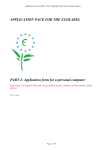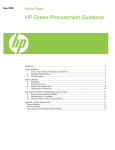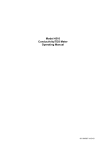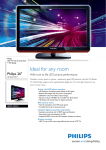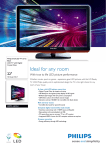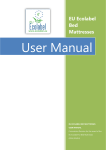Download APPLICATION PACK FOR TELEVISIONS
Transcript
APPLICATION PACK FOR THE ECOLABEL Application form for televisions (ecolabelling criteria 12 March 2009) Page 1 of 17 Insert name and contact details of the Member State Competent Body(s) You can see which other products have been awarded the label by visiting the European Commission’s Ecolabel catalogue at http://www.eco-label.com/. If you need more information, please contact us. We will be pleased to help. Page 2 of 17 Introduction 1. This document contains an application form for the award of the Ecolabel to a television, plus the full technical criteria (in the Annex). Product group definition and criteria 2. The product group definition for a television is set out below: ‘Mains powered electronic equipment, the primary purpose and function of which is as a device that receives, decodes and displays TV transmission signals.’ 3. Criteria for the Ecolabel for televisions take into account the various environmental impacts at each stage of the product’s life, including energy consumption. They are listed in the formal Commission Decision of 2009/300/EC (see Annex). 4. The criteria aim in particular at encouraging energy efficiency and recycling at the end of the television’s life. 5. Specifically, the criteria aim to promote • the reduction of environmental damage or risks related to the use of energy (global warming, acidification, depletion of non-renewable resources) by reducing energy consumption • the reduction of environmental damage related to the use of natural resources by encouraging the reuse, recyclability and maintainability of a television • the reduction of environmental damage or risks related to the use of hazardous substances by reducing the use of such substances. The criteria encourage the implementation of best practice (optimal environmental use) and enhance consumers’ environmental awareness. Furthermore, the marking of plastic components encourages the recycling of the product. The criteria are set at levels that promote the labelling of televisions that are produced with a low environmental impact. 6. These revised criteria are valid for 4 years, from 1 November 2009 until 31 October 2013. Health, safety and other environmental requirements 7. Products awarded Ecolabels must also comply with the general provisions of the Regulation. Article 2 of the Regulation states that the label may not be awarded to substances or preparations classified as very toxic, toxic, dangerous to the environment, carcinogenic, toxic for reproduction, or mutagenic in accordance with Council Directive 67/548/EEC or Directive 1999/45/EC, or to goods manufactured by Page 3 of 17 processes which are likely to significantly harm man and / or the environment, or which in their normal application could be harmful to the consumer. Page 4 of 17 Application for the EU Ecolabel for a Television Compliance with the criteria is shown by a mixture of tests and applicant’s declarations, as indicated in Section 2 of the form. Applicants should complete Sections 1 and 2 of this form (in black, either typescript or manuscript) and submit two paper copies - not e-mails. Applicants should also provide a technical dossier of laboratory test reports, and send this and keep an up-to-date file on their premises to show continuing compliance with the criteria. The dossier should include an illustration of how applicants intend to use the Ecolabel on the product and packaging, so that the Competent Body can satisfy itself that the label will be properly used. It will greatly help the application process if applicants carefully check that they have assembled all the information required for the Ecolabel before submitting their application. Delays will invariably arise if incomplete applications are submitted. Section 1 – details of applicant and product Please complete or type in black, and submit in duplicate (as a paper copy, not by e-mail) to the Competent Body and AEA Energy and Environment. A. The applicant Full name of applicant company: Address (this should be the company address you want us to use in the contract): Contact name, and function: Tel no, and fax no: E-mail: Manufacturer’s internet site: In what capacity are you applying for the Ecolabel? (manufacturer, importer, service provider, trader or retailer) Page 5 of 17 For official use B. The product Registered trade name of product or product range, and any trademarks: Model or internal reference number(s): Please describe the type of product: Name and address of manufacturing site (if different from the company address given in section A above): Where the product is made outside the EU, please confirm that it has been or will be placed on the market in the EU (see the separate Guide for Applicants note): EU countries in which this product is manufactured in the same form (if sold under different names, please give names): EU countries in which this product is sold (if sold under different names, please give names): Rough estimate of annual number of articles produced: Rough estimated value of annual sales, excluding VAT, in the European Economic Area (ie the European Community plus Norway, Iceland and Liechtenstein) of the product at ex-factory prices (in £ sterling): ie before transport to the purchaser’s premises or there is a wholesaler’s or retailer’s profit – so excluding the cost of carriage, carriage insurance, and settlement discounts, but including any bulk discount (which is where the customer is offered a percentage reduction in the total price when ordering large quantities of goods). Page 6 of 17 C. This application Is this the first application for the EU Ecolabel for this product? (if not, when and where was the first application made, and with what outcome?) Is this an application to add a new product (that is, with a technical formulation not covered by an existing Ecolabel that you hold) to a licence for a product range already covered by an Ecolabel? (if so, please give details of the existing Ecolabel) Please name any other environmental labelling schemes under which the product has already been registered, such as the Nordic Swan: The assessment and certification method I have used is: certified self-assessment / independent third party assessment: (please say which) The approved test centre is: The Competent Body will invoice applicants for a non-returnable application fee on receipt of the application. If the application is successful, the Competent Body will invoice the licensee for an annual fee, as explained in the separate Guide for Applicants note. The Competent Body will apply all relevant reductions. 1. Do you wish to claim a fee reduction as an SME? If so, does your company employ fewer than 250 people; and have an annual turnover not exceeding 50 million euros, and / or an annual balance sheet total not exceeding 43 million euros? (these are the qualifying criteria) 2. Do you wish to claim a fee reduction for EMAS registration or ISO certification? If so, please provide proof of status. 3. Where the product uses components for which an Ecolabel fee has already been paid, the annual fee will be based on the annual sales of the products after deduction of the cost value of the components. Do you wish to claim a reduction on these grounds? Please provide details if relevant. Please note: A new fee system is soon to be agreed for all Ecolabel applications, but was not in place at the time of writing this application pack. Please contact your competent body for details Page 7 of 17 D. Applicant’s undertaking (all applicants must sign and date this undertaking: there is a link to Regulation EC No 1980 / 2000 in the separate Guide for Applicants note) As the applicant for an EU Ecolabel, I hereby declare that: I understand and accept the provisions of Regulation EC No 1980 / 2000 on the EU Ecolabel scheme, and in particular Article 2, which states that the Ecolabel may not be awarded to goods manufactured by processes which are likely to significantly harm man and / or the environment, or which in their normal application could be harmful to the consumer; I understand and accept the standard assessment and contract procedures proposed by the Competent Body, and accept its terms during the duration of the contract; I undertake to ensure that the product compiles with the Ecolabel criteria at all times and to notify the Competent Body immediately of any significant modification to it or to the production processes; I take responsibility for the correct and proper use of the EU Ecolabel. Signed: Name in capitals: Position in company: Date: Page 8 of 17 Section 2 – Compliance undertakings For a television, the information required to show compliance with each of the criteria is as follows: Test report Energy Savings Passive stand-by consumption Clearly visible hard-off switch (where fitted) Maximum energy consumption Energy efficiency Energy saving information in User Instructions Mercury content of fluorescent lamps Lifetime extension Eco-design Heavy metals and flame retardants User instructions Information appearing on the Ecolabel Declaration and supporting documents √ √ (and photo) √ √ √ √ √ √ √ √ √ In order for the applicant to show compliance with these requirements, the following documentation is to be provided with the application; • • • • • • • Report(s) showing compliance of the product with each test requirement Information showing that the laboratory(s) where the testing was conducted meet the general requirements expressed in EN ISO 17025 Suitable information for the Competent Body to determine that the product meets all criteria where the applicant has declared compliance with the criteria. The user manual for the product A disassembly report Information on how the user will be made aware that this product has been awarded the ecolabel. An illustration of the proposed usage of the Ecolabel on the product and/or packaging, so that the Competent Body can satisfy itself that the label will be properly used. Where no specific requirements about the test method are stated, the Competent Body simply expects applicants to make what they regard as reasonable tests, and to keep the report on these tests ready in case it is required. This information must be collated in a dossier to demonstrate that the product complies with the criteria. Two copies of the form and dossier must be signed where shown, and submitted by post (not e-mail) with the application forms to the Competent Body at the address on the cover of this pack. If the application is successful, the applicant will be expected to retain the dossier and keep it up to date for the duration of the licence. Page 9 of 17 Please complete or type in black and submit in duplicate as a paper copy (not by e-mail) to the Competent Body. Indicate, using the spaces in the following tables, if the product meets each criterion, and that either a report or other information, as appropriate, showing that the product complies with the criterion is provided to the Competent Body. 1. Energy savings a) Passive Standby either i. option 1 Requirement Yes The passive stand-by consumption of the television is ≤ 0.3 watts Report provided to the Competent Body stating that the measured level of power consumption in the passive stand-by mode, measured using the procedure in IEC 62087 is ≤ 0.3 watts No or ii. option 2 Requirement Yes The televisions has a clearly visible hard-off switch. A photo of the switch is provided for the Competent Body to assess. When the switch is operated to the off position, the television’s energy consumption is < 0.01 watts. The passive stand-by consumption of the television is ≤ 0.5 watts Report provided to the Competent Body stating that the measured level of power consumption when switched off is <0.01 watts and that in the passive stand-by mode, measured using the procedure in IEC 62087 is ≤ 0.5 watts No Note: The position of hard-off switch must be clearly visible for the user of the TV and not hidden from view. Where a hard-off switch is not placed on the front of the TV, the location of the switch must be clearly indicated from in front of the TV. If there is any doubt about this issue there may be a delay in your application as the competent body will have to consult other competent bodies about the location of the hard-off switch. b) Maximum Energy Consumption Requirement Yes Televisions shall have an absolute maximum energy consumption of ≤ 200 watts. Report provided to the Competent Body stating that the measured power consumption in the on-mode in its as-delivered state, measured using the procedure in IEC 62087 is ≤ 200 watts. Page 10 of 17 No c) Energy Efficiency Requirement Yes The television has an on-mode energy efficiency ≤ 0.64 · (20 W + A · 4,3224 W/dm2) , where A is the visible screen area 1 . Report provided to the Competent body stating that the television was tested for its on-mode power consumption in its condition as delivered to the customer, according to IEC62087. If the television has a forced menu upon initial start up, the default shall be the setting which is recommended by the manufacturer for normal home use. No In this case the licence can be awarded until 31 December 2010. Requirement Yes The television has an on-mode energy efficiency ≤ 0.51 · (20 W + A · 4,3224 W/dm2) , where A is the visible screen area. Report provided to the Competent body stating that the television was tested for its on-mode power consumption in its condition as delivered to the customer, according to IEC62087. If the television has a forced menu upon initial start up, the default shall be the setting which is recommended by the manufacturer for normal home use. No In this case the licence can be awarded until 31 December 2012. Requirement Yes The television has an on-mode energy efficiency ≤ 0.41 · (20 W + A · 4,3224 W/dm2) , where A is the visible screen area. Report provided to the Competent body stating that the television was tested for its on-mode power consumption in its condition as delivered to the customer, according to IEC62087. If the television has a forced menu upon initial start up, the default shall be the setting which is recommended by the manufacturer for normal home use. No In this case the licence can be awarded until 31 December 2013, or longer if the validity of the product group criteria is extended. Note: Where the '0.64' or '0.51' time limited licences are awarded, these licences may be extended in time by the Competent Body, subject to test reports showing the television in question now meet the higher efficiency requirements. In such cases a declaration shall be provided by the manufacturer stating that all other aspects of the television remain unchanged and in line with the other criteria. 2. Mercury content of Fluorescent Lamps For televisions with screens with a visible screen diagonal of up to and including 40 inches (101cm): 1 Screen Area: This is the area of the screen in cm2. It is equal to [screen size × screen size × 0.480] for a standard screen (4:3 aspect ratio), and [screen size × screen size × 0.427] for a wide screen (16:9 aspect ratio). Page 11 of 17 Requirement Yes Taken together, all the lamps in the television contain no more than 75mg Hg in total. A signed declaration that their television complies with these requirements and documentation on the mercury content of lamps from suppliers. No For televisions with screens with a visible screen diagonal greater than 40 inches (101cm): Requirement Yes Taken together, all the lamps in the television contain no more than 99mg Hg in total. A signed declaration that their television complies with these requirements and documentation on the mercury content of lamps from suppliers. No 3. Lifetime extension Requirement Yes A manufacturer’s guarantee ensuring that the television will function for at least 2 years from the date of delivery to the customer is provided to the customer. The availability of compatible electronic parts is guaranteed for 7 years from the time that production of the television ceases. Suitable declarations and information for the Competent Body to determine that the product meets this criterion is provided to the Competent Body, including a copy of text in the televisions user manual, for the customer to see, stating that the product has a full 2 year guarantee and that electronic spare parts will be made available for 7 years, with contact details (customer service postal or website address, email or telephone) for finding such parts or for having the television repaired if not functioning. No Note: “guarantee” is interpreted as described in EU directive 1999/44/EC. However, in this case, the Ecolabel requirements go beyond the simply legal provisions in this directive. 4. Design for Disassembly Requirement The manufacturer has demonstrated that the television can be easily dismantled by professionally trained recyclers, using the tools usually available to them. This is to enable: • The undertaking of repairs and replacements of worn-out parts • Upgrades to older or obsolete parts and • Separation of parts and materials, ultimately for recycling. To facilitate this: • Fixtures within the television shall allow for this disassembly, e.g. screws, snap-fixes, especially of parts containing hazardous substances. • Plastic parts shall be of one polymer or be of compatible polymers for recycling and have the relevant ISO11469 marking if greater than 25g in mass. Page 12 of 17 Yes No • Metal inlays shall not be used that cannot be separated. Data on the nature and amount of hazardous substances in the television should be gathered in accordance with the Dangerous Substances Directive 67/548/EEC and its subsequent amendments and the Globally Harmonised System of Classification and Labelling of Chemicals (GHS). A test report is submitted with the application detailing the dismantling of the television. This includes an exploded diagram of the television labelling the main components as well as identifying any hazardous substances in components. This can be in written or audio-visual format. Information regarding hazardous substances is provided to the awarding competent body in the form of a bill of materials identifying material type, quantity used and location. 5. Heavy Metals and Flame retardants Yes Cadmium, lead, mercury, chromium 6+ or poly-brominated biphenyl (PBB) or poly-brominated diphenyl ether (PBDE) flame retardants, as listed in Article 4 of Directive 2002/95/EC of the European Parliament and Council, are not be used in the television taking into account the thresholds specified in Commission Decisions 2005/618/EC, 2005/717/EC and 2005/747/EC amending Directive 2002/95/EC. (For PBBs and PBDEs the threshold concentration identified in Commission Decision 2005/618/EC shall be <0.01%. ) Plastic parts do not contain flame retardant substances or preparations containing substances that are assigned or may be assigned, at the time of application, any of the following risk phrases: • R40 (possible risk of cancer) • R45 (may cause cancer), • R46 (may cause heritable genetic damage), • R50 (very toxic to aquatic organisms), • R51 (toxic to aquatic organisms), • R52 (harmful to aquatic organisms), • R53 (may cause long-term adverse effects in the aquatic environment), • R60 (may impair fertility) or • R61 (may cause harm to the unborn child), as defined in Council Directive 67/548/EEC of 27 June 1967 on the approximation of the laws, regulations and administrative provisions relating to the classification, packaging and labelling of dangerous substances (1) and its subsequent amendments. A signed certificate declaring compliance with the requirement to the awarding competent body is provided. A declaration of compliance, signed by the plastic and flame retardant suppliers is provided. Copies of relevant Material Data Safety Sheets are copied to the awarding Page 13 of 17 No competent body. NOTE: plastic cable housing is not considered as a 'plastic part'. Note: only plastic parts of weight greater than 25 grams be considered within the boundaries of this criterion. 6. User instructions Requirement The television is sold with relevant user information that provides advice on its proper environmental use. The information is located in a single, easy-to-find place in the user instructions as well as on the manufacturer’s website. The information includes, but is not be limited to, the following: (a) The television’s power consumption in the various modes: on, off, passive standby, including information on energy savings possible in different modes. (b) The television’s average annual energy consumption expressed in kWh, calculated on the basis of the on-mode power consumption, operating 4 hours a day and 365 days a year. (c) Information that energy efficiency cuts energy consumption and thus saves money by reducing electricity bills. (d) The following indications on how to reduce power consumption when the television is not being watched: Yes No Yes No - turning the television off at its mains supply, or un-plugging it, will cut energy use to zero for all televisions, and is recommended when the television is not being used for a long time, e.g. when on holiday, - using the hard off-switch will reduce energy use to near zero (where one is fitted), - putting the television into standby mode, will reduce energy consumption, but will still draw some power, - reducing the brightness of the screen will reduce energy use. (e) The position of the hard off-switch (where one is fitted). (f) Repair information regarding who is qualified to repair televisions, including contact details as appropriate. (g) End-of-life instructions for the proper disposal of televisions at civic amenity sites or through retailer take-back schemes as applicable, which shall comply with Directive 2002/96/EC of the European Parliament and of the Council (1). (h) Information that the product has been awarded the flower (the EU Ecolabel) with a brief explanation as to what this means together with an indication that more information on the Ecolabel can be found at the website address http://www.ecolabel.eu Note: user manual may be provided online. 7. Information appearing on the Ecolabel Requirement Box 2 of the ecolabel contains the following text: “High energy efficiency” Page 14 of 17 Box 2 of the ecolabel contains the following text: “Reduced CO2 emissions” Box 2 of the ecolabel contains the following text: “Designed to facilitate repair and recycling” The applicant provides a declaration of compliance with this requirement. The applicant provides a copy of the Ecolabel as it appears on the product packaging and/or product and/or accompanying documentation. Page 15 of 17 Statement that the product meets all ecolabel criteria As the applicant for an EU Eco-label, I hereby declare that the product meets all of the criteria which are required for this product to be awarded an ecolabel. This . application includes two copies of a dossier which contains the following information • • • • • • • Report(s) showing compliance of the product with each test requirement Information showing that all tests have been conducted in a laboratory which meets the general requirements expressed in standard EN ISO 17025 Suitable information for the Competent Body to determine that the product meets all criteria where the applicant has declared compliance with the criteria The user manual for the product A disassembly report Information on how the user will be made aware that this product has been awarded the ecolabel. An illustration of the proposed usage of the Ecolabel on the product and packaging. If the application is successful, the applicant will retain a copy of the dossier and keep it up to date for the duration of the licence Signed: : Name in capitals: Position in company: Date Page 16 of 17 Annex Commission Decision on ecolabel criteria for a television * This annex is provided by a hyperlink where the application pack is sent out by e-mail – http://ec.europa.eu/environment/ecolabel/product/pg_television_en.htm - or as a paper copy when the application form is sent by post. Page 17 of 17

















